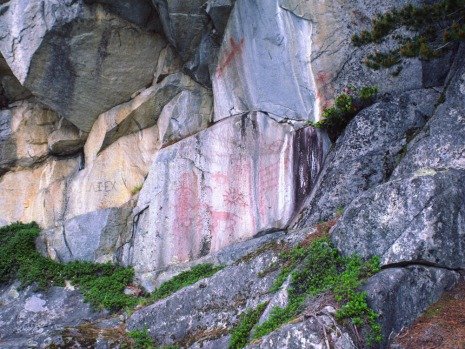 By Paula de Jong
By Paula de Jong
Published: Aug 4, 2014
The Howe Sound is already known for world class views, wildlife sightings, endless adventures and recreation opportunities. In addition to this, the area has even more to offer through its rich history. The best place to start this historical journey is at the place where it began: Navigating the waters of the Howe Sound. We have created this guide on how to best explore the historical and cultural offerings of the beautiful Howe Sound.
The awe inspiring views of dramatically steep mountains rising sharply from the ocean are best experienced from the water. The landscape that provides us with endless adventures was formed about 15,000 years ago when our valley was covered with ice. This was a rugged and uninhabitable time of volcanic action and frozen landscapes, with only the highest peaks showing above the frozen landscape.
The slow glacial melt eventually carved out the current habitable landscape. Archeological studies date the first inhabitants of the area to over 9000 years ago; their culture has evolved into what we know today as the Coast Salish and Squamish Nations.

The Howe Sound and lush Squamish Valley was an ideal place to call home, with many native village sites located along the coast and rivers. A 1975 survey uncovered Archaeological sites on the islands of Keats, Bowen and Gambier. Shell middens, granite hammers, a basalt adze and many other artifacts have been discovered, provided a glimpse into historical life on the coast.
The Howe Sound is also home to several sacred burial sites. Native burial sites were often located on islands, as they provided protection from wolves who roamed the area. Remains have been found at Gower Point near Gibsons, and on other small islands in the Howe Sound.
In addition to these artifacts and sacred grounds, First Nations pictographs can be found on the rock walls of the Howe Sound at tide line. Furry Creek is home to rock paintings believed to be anywhere from 800 to 3000 years old. The site is currently undergoing carbon dating to determine the exact age. These images are of the same style as other First Nations Art found all the way from California to Siberia. In addition to these archaeological sites, the Howe Sound is surrounded with a history of fascinating stories to discover.
A Tale of The Howe Sound: Where the Wild Things Roam!
The Pacific West Coast is filled with stories and sightings of the Sasquatch or Bigfoot, and these “wild people” may be closer to home than you realized! On the western side of the Howe Sound, directly across from Britannia Beach, is a steep cliff recently rediscovered by rock climbers. The area is known as “Where the Foot Finishes” by the Squamish Nation, and it is the starting point for a tale filled with love, betrayal and wild things!
The story starts with the only daughter of a Sta-mus Chief and his and his slave. After learning that his daughter was pregnant with his slave’s baby, the Chief became overwhelmed with shame. The Chief took both the guilty slave and his daughter to the base of a massive cliff and left them there to perish. In some mysterious way, the pair managed to climb to the top and travel inland until they came to a lake where they built themselves a house and gave birth to the child. In time, a community grew in the mountainous lake country of western Howe Sound. The unusually tall men were known to be great hunters, and dressed in the untanned skins of animals they had slain. This community became to be known as the `Wild People` or “Smaylilh” to the Squamish Nation.
It is believed that this fated cliff on the western side of the Howe Sound may be the origins of what has become known as Sasquatch or Big Foot. Be aware of these tales if you land on the western side of the Howe Sound, and bring pepper spray for animals of all shapes and sizes.
For the complete story of the “Wild People” please visit squamishadventure.com/news
The Best Ways to Access & Explore the Howe Sound:
If this article has intrigued the explorer in you, check out the many fun ways you can navigate the Howe sound this summer:
For the Independent Explorer:
Rent a boat and head out to sea. The friendly owners at Harbour Boat Rentals are long time Squamish locals, with a abundance of knowledge on the area. They will advise your group on the top locations, wildlife viewing spots and provide a map for your journey.
For the Guided Explorer:
Book a guided tour to take you through the historical sightings of the Howe Sound. The knowledgeable guys at Squamish Marine Services run sightseeing and historical guided tours on their water taxi boats. Book a full day tour and make your way to Gibsons or Horseshoe bay for lunch. In addition to a historical journey, you will be treated to amazing wildlife sightings of herons, seals, dolphins and for the lucky, killer whales. Although they don’t currently offer whale watching tours, they are always watching for whales!
For the Self Propelled Explorer:
Discover the historical Howe Sound the way the original inhabitants did, with no engines. Kayak and Stand up Paddle Boards are available to rent, although we strongly advise those without experience to take a guided tour. Stand up paddle board tours depart from Squamish and head down to Britannia Beach. Guided kayaking tours through the estuary start with a historical journey on the blind channel as you make your way to the estuary. For guided tours and rentals book through the adventure experts found at www.SquamishAdventure.com
For the Birds Eye View:
If you dare to explore the mystical lake country where the wild people are, Sea to Sky Air now offers float plane tours. Find some fellow brave explorers and hire a float plane for the day to check out alpine mountain lakes like Brennan, Hennette & Sylvia. All which could have been the original home of the “wild people” community.
Squamish is home to a world of fun for adventurers of all types. Our access to the Howe Sound offers more than just stunning views, wildlife sightings and endless recreational opportunities; it allows a journey through history. Be sure to organize a day exploring the ocean this summer and check out www.squamishadventure.com for more exploring ideas, inside adventure tips and to book all of these activities and more.
A Note on Exploring Responsibly:
When visiting the islands and waterways of the Howe Sound, explorers should be aware of the protected areas of burial sites and other archeological sites. Please respect these areas, and explore responsibly!
- Enjoy the paintings from afar, take as many pictures as you like, but under no circumstance should you enter or disturb these Archeological sites.
- Do not disturb the wildlife or leave traces of your visit.
- Certain island are bird sanctuaries and native burial grounds. These protected lands are “No Go” zones to be enjoyed from the water only, so know before you go!




Peter Legere says
It doesn’t seem correct to use the definite article “the” when referring to Howe Sound. Odd, when you consider it; one doesn’t refer to “the Watts Point” or “The Mount Garibaldi” but “The Squamish River” rolls off the tongue quite handily. Howe Sound is an arm of Georgia Strait, but it seems ok to refer to it as “The Strait of Georgia” or “The Salish Sea”. There doesn’t seem to be a rule.
Ahh….English….
Geo Hyperform says
Is this a tourism brochure ? It sure reads like one. PS Squamish may be a nation but Coast Salish is not. Technically it is a language or broad cultural designation comprising many nations within it. These are rather important things to get right . Not because its insensitive, but because it creates more confusion, which has a tendency to muddy the waters of the already-murky Salush Sea